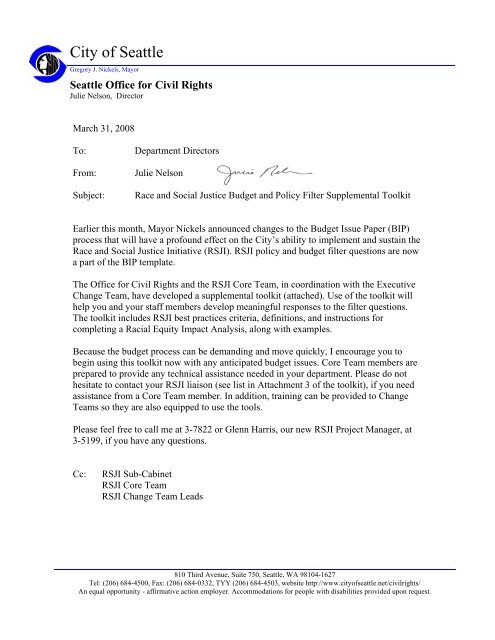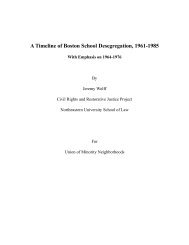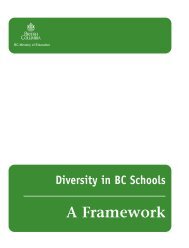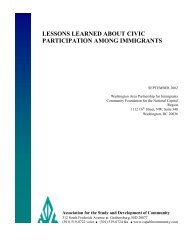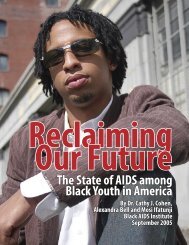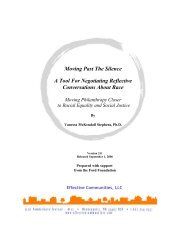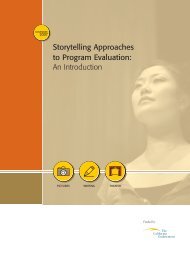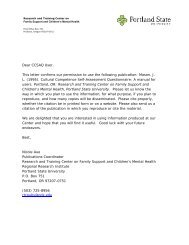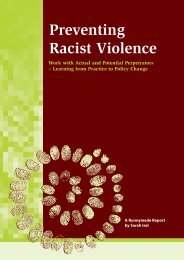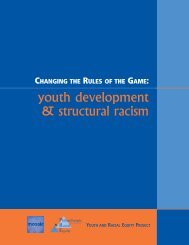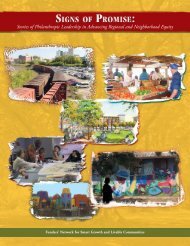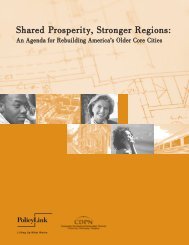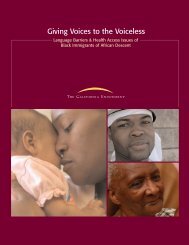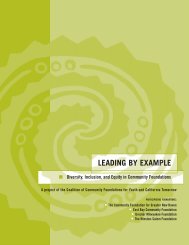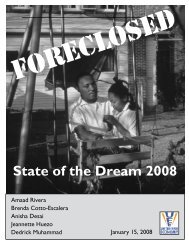LETTER HEAD - Racial Equity Tools
LETTER HEAD - Racial Equity Tools
LETTER HEAD - Racial Equity Tools
Create successful ePaper yourself
Turn your PDF publications into a flip-book with our unique Google optimized e-Paper software.
City of Seattle<br />
Gregory J. Nickels, Mayor<br />
Seattle Office for Civil Rights<br />
Julie Nelson, Director<br />
March 31, 2008<br />
To:<br />
From:<br />
Subject:<br />
Department Directors<br />
Julie Nelson<br />
Race and Social Justice Budget and Policy Filter Supplemental Toolkit<br />
Earlier this month, Mayor Nickels announced changes to the Budget Issue Paper (BIP)<br />
process that will have a profound effect on the City’s ability to implement and sustain the<br />
Race and Social Justice Initiative (RSJI). RSJI policy and budget filter questions are now<br />
a part of the BIP template.<br />
The Office for Civil Rights and the RSJI Core Team, in coordination with the Executive<br />
Change Team, have developed a supplemental toolkit (attached). Use of the toolkit will<br />
help you and your staff members develop meaningful responses to the filter questions.<br />
The toolkit includes RSJI best practices criteria, definitions, and instructions for<br />
completing a <strong>Racial</strong> <strong>Equity</strong> Impact Analysis, along with examples.<br />
Because the budget process can be demanding and move quickly, I encourage you to<br />
begin using this toolkit now with any anticipated budget issues. Core Team members are<br />
prepared to provide any technical assistance needed in your department. Please do not<br />
hesitate to contact your RSJI liaison (see list in Attachment 3 of the toolkit), if you need<br />
assistance from a Core Team member. In addition, training can be provided to Change<br />
Teams so they are also equipped to use the tools.<br />
Please feel free to call me at 3-7822 or Glenn Harris, our new RSJI Project Manager, at<br />
3-5199, if you have any questions.<br />
Cc:<br />
RSJI Sub-Cabinet<br />
RSJI Core Team<br />
RSJI Change Team Leads<br />
810 Third Avenue, Suite 750, Seattle, WA 98104-1627<br />
Tel: (206) 684-4500, Fax: (206) 684-0332, TYY (206) 684-4503, website http://www.cityofseattle.net/civilrights/<br />
An equal opportunity - affirmative action employer. Accommodations for people with disabilities provided upon request.
City of Seattle<br />
Race and Social Justice Initiative<br />
Budget and Policy Filter<br />
Supplemental Toolkit<br />
March, 2008<br />
Section I<br />
Section II<br />
Section III<br />
Section IV<br />
Section V<br />
Attachment 1<br />
Attachment 2<br />
Attachment 3<br />
Introduction<br />
Race and Social Justice Best Practices Criteria<br />
<strong>Racial</strong> <strong>Equity</strong> Impact Analysis Worksheet Instructions<br />
<strong>Racial</strong> <strong>Equity</strong> Impact Analysis Worksheet<br />
Example Applications<br />
Memo from the Mayor about the RSJ Budget and Policy Filter<br />
RSJ Budget and Policy Toolkit Key Definitions<br />
RSJI Departmental Liaisons
I: Introduction<br />
All departments are implementing annual Race and Social Justice (RSJ) work plans,<br />
focusing on their own lines of business. In addition, department director accountability<br />
agreements with the Mayor include RSJ priorities. Department work plans include<br />
strategies for reducing racial disparity and fostering multiculturalism. Work is being done to<br />
address five areas common across departments:<br />
• Workforce equity<br />
• Economic equity<br />
• Public engagement<br />
• Immigrant and refugee inclusion and access to services<br />
• Capacity building<br />
In addition, each City department has an RSJI Change Team, a group of employees that<br />
helps lead RSJI work within the department, including implementation of work plans.<br />
Now all City departments are beginning to use an RSJI Budget and Policy Filter on a<br />
routine basis to further incorporate the Initiative into the City’s budget and policy<br />
development processes. Fairness and inclusion are the cornerstones of the Mayor’s<br />
priorities for the City of Seattle. All who work in City government have a role to play in<br />
achieving race and social justice, and the budget and policy-making process is central to<br />
that effort.<br />
The filter is a simple set of questions:<br />
1. How does this action accomplish the Mayor’s Race and Social Justice Initiative?<br />
How did you determine the reasoning for your response?<br />
2. Please identify any unintended consequences from this proposal.<br />
These questions will be incorporated into City budget and policy processes, beginning<br />
most immediately with Budget Issue Papers (see Attachment 1 for the memo from the<br />
Mayor describing the filter and budget process). Departments are encouraged to use this<br />
toolkit on a routine basis to develop and/or improve programs, policies and procedures.<br />
The toolkit is a more in-depth resource to supplement the Budget and Policy Filter<br />
questions. These tools, including identification of a set of RSJ best practices and a <strong>Racial</strong><br />
<strong>Equity</strong> Impact Analysis, should be used to help develop informed responses to the RSJI<br />
Budget and Policy Filter questions. Because of the importance of understanding<br />
terminology included throughout this toolkit, key definitions are included in Attachment 2.<br />
The toolkit includes the following:<br />
• Section II: Race and Social Justice Best Practices Criteria<br />
• Section III: <strong>Racial</strong> <strong>Equity</strong> Impact Analysis Worksheet Instructions<br />
• Section IV: <strong>Racial</strong> <strong>Equity</strong> Impact Analysis Worksheet<br />
• Section V: Example Applications (examples are included for illustrative<br />
purposes only, and although they bear some relation to existing<br />
City initiatives, may not reflect most current realities)
• Attachment 1 Memo from the Mayor about the RSJ Budget and Policy Filter<br />
• Attachment 2 RSJ Budget and Policy Toolkit Key Definitions<br />
• Attachment 3 RSJI Departmental Liaisons<br />
When a budget or policy issue is under consideration, the following steps should be<br />
followed:<br />
Step 1<br />
Step 2<br />
Step 3<br />
Step 4<br />
Step 5<br />
Step 6<br />
Review RSJ Best Practices Criteria (see Section II), the <strong>Racial</strong> <strong>Equity</strong> Impact<br />
Analysis instructions (see Section III), and examples of completed analyses<br />
(see Section V).<br />
Identify appropriate staff to complete the analysis; determine whether Core<br />
Team assistance would be beneficial. Core Team assistance can be arranged<br />
via your departmental RSJI Liaison (see list in Attachment 3).<br />
Collect data necessary for completion of the <strong>Racial</strong> <strong>Equity</strong> Impact Analysis<br />
(see Section III for resources).<br />
Complete <strong>Racial</strong> <strong>Equity</strong> Impact Analysis Worksheet (see Section IV).<br />
Complete and submit Budget Issue Paper (or other documents) within your<br />
department to appropriate staff.<br />
Your Department Finance Director or Department Director submits materials<br />
to Department of Finance or Mayor’s Office<br />
Worksheet responses need not be submitted along with Budget Issue Papers, Senior Staff<br />
briefings or legislative review. If after reviewing responses to filter questions, Department<br />
of Finance, Office for Policy and Management and/or Office for Intergovernmental<br />
Relations staff have questions, additional information will be requested.<br />
The City of Seattle RSJ Best Practices Criteria and <strong>Racial</strong> <strong>Equity</strong> Impact Analysis tool<br />
have been developed by the RSJ Core Team. The Core Team reviewed, learned from,<br />
and would like to acknowledge the excellent work of others, including the Annie E Casey<br />
Foundation and their Race Matters <strong>Racial</strong> <strong>Equity</strong> Impact Analysis tool, President Clinton’s<br />
Initiative on Race, the Aspen Institute, and the Applied Research Center’s <strong>Racial</strong>ly<br />
Equitable Policy Development Guide.
II.<br />
Race and Social Justice Best Practices Criteria<br />
The criteria below will be used to identify actual best practices so they can be shared<br />
and replicated. As departments gain experience with the Budget and Policy Filter and<br />
<strong>Racial</strong> <strong>Equity</strong> Impact Analysis, we anticipate that these best practices criteria will be<br />
refined.<br />
RSJI best practices will meet the following criteria:<br />
1. Assess community conditions and the desired community impact<br />
• Includes clear documentation of the existing community conditions, including<br />
disparities.<br />
• Explicitly enumerates specific goals and outcomes to emphasize program goals<br />
of reducing racism and decreasing racial disparities (as well as other program or<br />
policy goals).<br />
• Incorporates design to adjust goals and practices to keep pace with changing<br />
needs and racial demographics.<br />
2. Expand opportunity and access for individuals<br />
• Increases opportunity and/or access for those who historically have been<br />
excluded.<br />
• Integrates strategies to improve access for immigrants and refugees, including<br />
appropriate interpretation and translation policies.<br />
3. Affect systemic change<br />
• Reforms the ways in which institutions operate to lessen racial disparities and<br />
eliminate discrimination.<br />
• Analyzes and changes policies and practices that may perpetuate racial<br />
disparities and/or institutionalized racism.<br />
4. Promote racially inclusive collaboration and civic engagement<br />
• Creates opportunities for collaboration that fosters mutual respect among people<br />
who fully represent Seattle’s racial diversity.<br />
• Provides opportunities for program participants and leaders or people affected by<br />
a policy to take action to address racial disparities and foster racial equity.<br />
• Fosters greater participation in civic engagement that can promote leadership in<br />
racial equity efforts.<br />
5. Educate on racial issues and raises racial consciousness<br />
• Explicitly educates about the importance of historical and contemporary facts<br />
regarding race, racism, and/or culture.<br />
• Educates and encourages sharing about race and racism, including the<br />
connections between personal feelings and experiences and race-related<br />
systemic issues in society.
III. <strong>Racial</strong> <strong>Equity</strong> Impact Analysis Worksheet Instructions<br />
The RSJI Budget and Policy Filter questions are as follows:<br />
1. How does this action accomplish the Mayor’s Race and Social Justice Initiative?<br />
How did you determine the reasoning for your response?<br />
2. Please identify any unintended consequences from this proposal.<br />
Actions under consideration will include a range of policies, programs and procedures.<br />
Analysis of some actions will be more readily evident than others, but the tool has been<br />
constructed such that it can be applied to all.<br />
Conducting a <strong>Racial</strong> <strong>Equity</strong> Impact Analysis at the earliest possible stage of development<br />
or revision of a policy, program or procedure will help to ensure actions are aligned with<br />
the RSJ Initiative. The analysis should be completed by people who bring different racial<br />
and economic perspectives, ideally including both people of color and white people. This<br />
will maximize the valuable learning experience and allow the action to be shaped in a<br />
racially equitable manner.<br />
Considering RSJI Best Practices criteria and completed a <strong>Racial</strong> <strong>Equity</strong> Impact Analysis<br />
will help develop responses to the filter questions. <strong>Racial</strong> <strong>Equity</strong> Impact Analysis<br />
questions, along with references to useful resources, are as follows:<br />
<strong>Racial</strong> <strong>Equity</strong> Impact Analysis<br />
Questions<br />
Resources<br />
1. Lead department<br />
. 2. Project title<br />
3. Briefly describe the proposed action<br />
and the desired results<br />
4. How does the proposed action impact<br />
(check all that apply):<br />
<strong>Racial</strong> disparity?<br />
Institutionalized racism?<br />
Multiculturalism?<br />
Please describe<br />
5. How does the proposed action<br />
support (check all that apply):<br />
Economic equity,<br />
including contracting?<br />
Immigrant and refugee<br />
access to services?<br />
Public engagement<br />
and outreach?<br />
Work force equity?<br />
Capacity building?<br />
Please describe<br />
Definitions of these terms are included in Attachment 2. If<br />
unfamiliar with these terms, a Core Team member can be<br />
assigned to help with the analysis.<br />
Historically Underutilized Business for economic equity<br />
http://www.seattle.gov/executiveadministration/small<br />
business/default.htm<br />
Immigrant and Refugee Guidelines<br />
http://www.seattle.gov/mayor/issues/rsji/immigrants/<br />
Interpretation Policy, including language maps and lists of<br />
interpretation and translation vendors<br />
http://inweb/immigrantsrefugees/#InterpTransPolicy<br />
Outreach and Public Engagement Policy<br />
http://inweb/rsji/publicengagement/
<strong>Racial</strong> <strong>Equity</strong> Impact Analysis<br />
Questions<br />
. 6. Who are the racial / ethnic groups<br />
affected by this program, policy or<br />
practice? How will each group be<br />
affected?<br />
Resources<br />
Demographics data and maps (GIS and Census tracts)<br />
http://www.census.gov/<br />
Language maps and lists of interpretation and translation<br />
vendors<br />
http://inweb/immigrantsrefugees/#InterpTransPolicy<br />
Disparities: A Snapshot of Seattle<br />
inweb.ci.seattle.wa.us/rsji/docs/RSJ_stats_sheet-final.pdf<br />
7. Have the voices of groups affected by<br />
the proposal been involved with its<br />
development? If not, why? Is there<br />
support for the proposal? Why or why<br />
not?<br />
Outreach and public engagement policy<br />
http://inweb/rsji/publicengagement/<br />
8. What strategies are being used, and<br />
how will they help achieve racial<br />
equity? Describe the resources,<br />
timelines, and monitoring that will<br />
help ensure success.<br />
9. Are there direct or indirect community<br />
impacts or benefits? Are there<br />
strategies to mitigate any negative<br />
impacts? Please describe.<br />
10. How have your Change Team or<br />
Core Team members assisted with<br />
the development or review of this<br />
action? Please describe.<br />
Core Team assistance can be arranged via your<br />
departmental RSJI Liaison (see list in Attachment 3).<br />
More information about the overall Race and Social Justice Initiative is available on the<br />
RSJI Inweb site: http://inweb/rsji/assistance.htm. More information about the budget<br />
process is available on the Department of Finance web site:<br />
http://inweb/financedepartment/budgetmanual.htm
IV.<br />
<strong>Racial</strong> <strong>Equity</strong> Impact Analysis Worksheet<br />
Answer the following questions:<br />
1. Lead Department: _________________________________________________<br />
2. Project Title: ______________________________________________________<br />
3. Briefly describe the proposed action and the desired results:________________<br />
____________________________________________________________________<br />
____________________________________________________________________<br />
____________________________________________________________________<br />
____________________________________________________________________<br />
4. How does the proposed action impact (check all that apply):<br />
<strong>Racial</strong> disparity?<br />
Institutionalized racism?<br />
Multiculturalism?<br />
Please describe:____________________________________________________<br />
_________________________________________________________________<br />
_________________________________________________________________<br />
_________________________________________________________________<br />
_________________________________________________________________<br />
_________________________________________________________________<br />
5. How does the proposed action support (check all that apply):<br />
Work force equity?<br />
Economic equity, including contracting?<br />
Immigrant and refugee access to services?<br />
Public engagement and outreach?<br />
Capacity building?<br />
Please describe:____________________________________________________<br />
_________________________________________________________________<br />
_________________________________________________________________<br />
_________________________________________________________________<br />
_________________________________________________________________<br />
_________________________________________________________________
6. Who are the racial / ethnic groups affected by this program, policy or practice? How will<br />
each group be affected? __________________________________________________<br />
______________________________________________________________________<br />
________________________________________________________________<br />
________________________________________________________________<br />
________________________________________________________________<br />
7. Describe the community members and/or groups who have been involved with<br />
the development of this proposal and the involvement process? Is there<br />
community support for or opposition to the proposal? Why? ________________<br />
________________________________________________________________<br />
________________________________________________________________<br />
________________________________________________________________<br />
________________________________________________________________<br />
________________________________________________________________<br />
________________________________________________________________<br />
8. What strategies are being used, and how will they help achieve racial equity?<br />
Describe the resources, timelines, and monitoring that will help ensure success.<br />
________________________________________________________________<br />
________________________________________________________________<br />
________________________________________________________________<br />
________________________________________________________________<br />
________________________________________________________________<br />
9. Are there direct or indirect community impacts or benefits? Are there strategies to<br />
mitigate any negative impacts? Please describe: _________________________<br />
________________________________________________________________<br />
________________________________________________________________<br />
________________________________________________________________<br />
10. How have your Change Team or Core Team members assisted with the<br />
development or review of this action? Please describe:_____________________<br />
________________________________________________________________<br />
________________________________________________________________
V. Example 1 1<br />
1. Lead department: Seattle Public Utilities<br />
2. Project title: Lidding of the Beacon Hill Reservoir<br />
3. Briefly describe the proposed action and the desired results:<br />
Currently the Beacon Hill Reservoir is an open reservoir that provides drinking water for<br />
SE Seattle businesses and residents. SPU would like to put a lid (cap) on the reservoir<br />
and expects the following results: protection of water source from environmental &<br />
human threats, conservation of water, reduced treatment needed, and 50 acres of park<br />
space added to Jefferson Park (one of the largest parks in SE Seattle)<br />
4. How does the proposed action impact (check all that apply):<br />
<strong>Racial</strong> disparity?<br />
Institutionalized racism?<br />
Multiculturalism?<br />
Please describe:<br />
Staff working on this project will receive relevant RSJ training to increase awareness<br />
and will work with consultants who have demonstrated expertise in involving and<br />
working with diverse communities. We will also look at contracting for this project and<br />
identify and promote historically under-utilized businesses (HUBs) that can assist with<br />
all phases. We will utilize available demographic information to identify populations for<br />
whom we should tailor our outreach and involvement strategies. We will solicit ideas<br />
from the community and consultant on how to incorporate multiculturalism into this<br />
process; and test, document and continue to use strategies that work. For example,<br />
prior or at our first meeting we will ask how communities prefer to receive information<br />
and how they prefer to communicate, etc. This will be used to create guiding principles<br />
and/or project values that help us understand when and how to achieve community buyin<br />
/ participation.<br />
5. How does the proposed action support (check all that apply):<br />
Work force equity?<br />
Economic equity, including contracting?<br />
Immigrant and refugee access to services?<br />
Public engagement and outreach?<br />
Capacity building?<br />
Please describe:<br />
Work force equity: We have reviewed job descriptions related to this and other<br />
projects and have worked closely with HR and consultants to get the word out.<br />
1 Examples are included for illustrative purposes only, and although they bear some relation to existing<br />
City initiatives, may not reflect most current realities
The job description has been expanded to included language skills and direct<br />
experience engaging communities.<br />
Economic <strong>Equity</strong>: We have reviewed the scope of the project and are working<br />
closely with SPU’s Environmental Justice and Service <strong>Equity</strong> division and<br />
Contractor Development and Competitiveness Center to promote this with HUBs.<br />
I&R Access: We will be working closely with SOCR’s public engagement manager<br />
and SPU’s EJ team to identify effective public engagement strategies.<br />
Capacity building: As was mentioned earlier, staff has received and will receive<br />
anti-racism training public engagement and other related training as needed. In<br />
addition we will be using BMP and other tools that have been developed<br />
(language maps, consultant list, etc.)<br />
6. Who are the racial / ethnic groups affected by this program, policy or<br />
practice? How will each group be affected?<br />
According to census data, Asian/Pacific Islander, East African, African American,<br />
and low income groups will be most affected by this project.<br />
7. Describe the community members and/or groups who have been involved<br />
with the development of the proposal and the involvement process. Is there<br />
community support for or opposition to the proposal? Why?<br />
We have been working with our consultant and have a staff person assigned to<br />
meet with community groups to get community input on this project. Funds for<br />
translation and interpretation, and hands-on activities have been budgeted to<br />
assist with language needs. We have compiled comments from all participants<br />
and they are included in this proposal.<br />
8. What strategies are being used, and how will they help achieve racial<br />
equity? Describe the resources, timelines, and monitoring that will help<br />
ensure success.<br />
We have worked with communities and partners to identify priorities, attached a<br />
timeline for what needs to get done, and have set up a community/partner<br />
steering committee to give and receive feed back on the status of the project.<br />
9. Are there direct or indirect community impacts or benefits? Are there<br />
strategies to mitigate any negative impacts? Please describe:<br />
Increased open/green space that represents/reflects community interest and<br />
needs.<br />
10. How has your Change Team or Core Team members assisted with the<br />
development or review of this action?<br />
We have met with our change team to let them know what is going on. We have<br />
also consulted with Michael Davis, Sharon King, Marget Chappel, Glenn Harris,<br />
Jacque Larrainzar, Darlene Flynn and other core team members as needed.
Example 2:<br />
1. Lead department: City Light<br />
2. Project title: Relamping Program<br />
3. Briefly describe the proposed action and the desired results:<br />
Seattle City Light is implementing a group relamping program for streetlights.<br />
The proposal outlines the steps SCL wants to take to engage a contractor to<br />
begin replacing 21,000 street lights. Then the utility will begin a rotating program<br />
to replace luminaires in neighborhoods in Seattle and the franchise cities that<br />
SCL serves. At present, the utility replaces street light bulbs as it becomes aware<br />
of outages from customers and other resources. This practice is more expensive<br />
than group relamping. Also, the customers are not as likely to experience street<br />
light outages.<br />
4. How does the proposed action impact (check all that apply):<br />
<strong>Racial</strong> disparity?<br />
Institutionalized racism?<br />
Multiculturalism?<br />
Please describe:<br />
City Light will be more responsive to fixing streetlights in neighborhoods with<br />
higher population density and higher crime rates. These areas will be serviced<br />
first as the crews move northbound and southbound from Denny Way, replacing<br />
streetlight luminaires. Better lighting provides a greater sense of security and<br />
helps to deter crime. Currently, City Light relies heavily on customers to report<br />
lights out. People who do not speak English fluently are less likely to call in<br />
outages.<br />
5. How does the proposed action support (check all that apply):<br />
Work force equity?<br />
Economic equity, including contracting?<br />
Immigrant and refugee access to services?<br />
Public engagement and outreach?<br />
Capacity building?<br />
Please describe:<br />
City Light will contract out for group streetlight repair work; we will be looking at<br />
HUBS. The contractors will work for prevailing wages for comparable work. By<br />
contracting this work out, City Light’s highly skilled high voltage crews will be free<br />
to perform more complex work assignments. Under the group streetlighting plan,<br />
City Light will no longer rely on customers to report streetlights outages. We<br />
anticipate that complaints about malfunctioning streetlights will significantly<br />
decrease throughout the service territory, but particularly in areas with higher<br />
immigrant populations.
6. Who are the racial / ethnic groups affected by this program, policy or<br />
practice? How will each group be affected?<br />
All racial and ethnic groups will be affected by this program. All customers will<br />
have better streetlighting due to fewer lights out and they won’t have to call City<br />
Light to report problems then wait for the repair to be completed.<br />
7. Describe the community members and/or groups who have been involved<br />
with the development of the proposal and the involvement process. Is there<br />
community support for or opposition to the proposal? Why?<br />
The group streetlighting program was developed in response to general<br />
community complaints and concerns about how long it takes to replace<br />
streetlights. Management is supportive of this program, and has been<br />
experimenting with this concept during 2008.<br />
8. What strategies are being used, and how will they help achieve racial<br />
equity? Describe the resources, timelines, and monitoring that will help<br />
ensure success.<br />
The group contracting work will be done on contract. The timeline: 500 crew days<br />
to relamp 21,000 lamps. Depending on the contractor’s staffing, the most<br />
populous Seattle neighborhoods will be relamped by the end of Daylight Savings<br />
time in 2008. When daylight is shorter, customers become more aware of<br />
streetlights that do not work. The quality and quantity of the contractor’s work will<br />
be monitored by the Dept. of Executive Administration/Purchasing and by City<br />
Light.<br />
9. Are there direct or indirect community impacts or benefits? Are there<br />
strategies to mitigate any negative impacts? Please describe:<br />
Better streetlighting; increased security for the citizens; helps decrease crime;<br />
and improves customer satisfaction.<br />
10. Has your Change Team or Core Team members assisted with the<br />
development or review of this action? Please describe:<br />
Yes, two RSJI core team members are assisting with review of this action and<br />
advising the program manager.
Example 3:<br />
1. Lead department: Co-led by SPU and HSD with partnerships from DON, SCL,<br />
OPM and City Council<br />
2. Project title: Increase utilization of the Utility Rate Assistance Program<br />
3. Briefly describe the proposed action and the desired results:<br />
Evaluate Utility Rate Assistance Programs, which include outreach,<br />
demographics, policies and procedures to help increase access and savings to<br />
qualified households.<br />
The Utility Rate Assistance Program helps low to moderate income SPU and<br />
SCL customers pay their utility bills by providing a 50% discount on electric,<br />
water, sewer and solid waste charges. The Utility Rate Assistance Program is<br />
administered by the Human Services Department and funded by Seattle City<br />
Light and Seattle Public Utilities. The purpose of the project is to examine<br />
demographic shifts in our customer base, current market penetration rates,<br />
outreach practices, effectiveness of existing program delivery mechanisms, and<br />
the impact of program policies, practices and procedures on participation rates.<br />
This evaluation will give us an updated understanding of who today’s customer<br />
is, how to better meet their needs, identify barriers to participation, and inform<br />
program changes that will increase program access and economic advantage for<br />
Seattle’s low to moderate income population. A report with budget considerations<br />
and proposed recommendations based on evaluation findings will be provided to<br />
City Council in May 2008.<br />
4. How does the proposed action impact (check all that apply):<br />
<strong>Racial</strong> disparity?<br />
Institutionalized racism?<br />
Multiculturalism?<br />
Please describe:<br />
Based on the results of the evaluation, it is expected to decrease disparities by<br />
providing increased access and economic advantages to low-income to median<br />
income households and communities of color.<br />
Through this analysis, institutional barriers have been identified within policies and<br />
procedures that currently exist. Some of these institutional barriers include:<br />
(1) Different income guidelines (200% Federal Poverty Level for low-income<br />
households vs. 70% State Median Income guideline for seniors who are at least<br />
65 years old or people with permanent disability income).<br />
(2) More income documentation is required for low-income households vs. seniors<br />
and people with a permanent disability income.<br />
(3) Federally subsidized housing residents (Section 8, SHA, KCHA, HUD,<br />
Shelter+Care, etc.) are not able to qualify for rate discounts (despite their lowincome<br />
status) because they receive a utility allowance along with their subsidized<br />
rent.
Decision and policy makers shall be briefed on the potential for increased benefits<br />
to underserved communities. This will forward our efforts in eliminating barriers<br />
experienced by these utility customers and reduce institutionalized racism.<br />
5. How does the proposed action support (check all that apply):<br />
Work force equity?<br />
Economic equity, including contracting?<br />
Immigrant and refugee access to services?<br />
Public engagement and outreach?<br />
Capacity building?<br />
Please describe:<br />
Work force equity: Hiring those who represent our customers/communities to<br />
help increase our language capacity in the workforce.<br />
Economic equity, including contracting: Improve the quality of life, put more<br />
money in the customer pockets and use this saving to focus on other basic<br />
needs such as food, shelter, medical, etc. Help improve health and well-being<br />
but not having more financial worries. By doing this, more public dollars will be<br />
channeled into the communities we serve.<br />
Immigrant and refugee access to services: Support language capacity through<br />
increased use of language line services and other means of interpretation. Help<br />
ensure that the printed information (brochure and application) are fully effective in<br />
those communities. Provide culturally competent outreach services to normally<br />
underserved populations.<br />
Public engagement and outreach: Help ensure that staff are culturally competent<br />
and able to provide quality public engagement. This would also be helpful for<br />
improving and building our relationship within the communities we serve.<br />
Capacity building: Increased cultural competency and on-going training and<br />
improvement as our demographics are changing.<br />
6. Who are the racial / ethnic groups affected by this program, policy or practice?<br />
How will each group be affected?<br />
Primarily people of color, immigrant and refugees, as well as underserved (seniors<br />
and people with disabilities). It is because of this evaluation/rate review, and the<br />
work we’ve done (evaluation from prior activities) that we know that a more thorough<br />
inclusive process is still needed.<br />
7. Describe the community members and/or groups who have been involved with<br />
the development of the proposal and the involvement process. Is there<br />
community support for or opposition to the proposal? Why?<br />
Yes, there has been support for this proposal but it would also depend on the cost<br />
effectiveness of the proposed / packaged recommendations.<br />
Community members and representatives who have been part of the outreach<br />
evaluation process include Environmental Justice Network in Action (EJNA) partners<br />
such as International District Housing Alliance, Asian and Pacific Islander Women
and Family Safety Center, Khmer Community Association of Seattle-King County,<br />
St. Mary’s Parish and Food Bank, Somali Community Services of Seattle and Horn<br />
of Africa Services.<br />
We also have reviewed feedback from participants from last fall’s summit, which<br />
included representatives from various non-profit organizations such as Catholic<br />
Community Services, SHA, Jewish Family Services, Neighborhood House, El Centro<br />
de la Rasa, Solid Ground, IDIC, ACRS, LIHI, Public Health & Consejo Counseling<br />
and Services.<br />
8. What strategies are being used, and how will they help achieve racial equity?<br />
Describe the resources, timelines, and monitoring that will help ensure<br />
success.<br />
Some of the strategies are: include our program partners: SPU, DON, HSD; access /<br />
review community feedback and program partners from the summit evaluation<br />
forms; review current outreach methodologies and budget; and review similar<br />
programs from other jurisdictions (Snohomish County, Portland and other cities in<br />
WA). This program is focused on economic equity within a group of residents who<br />
are primarily communities of color.<br />
9. Are there direct or indirect community impacts or benefits? Are there<br />
strategies to mitigate any negative impacts? Please describe:<br />
Yes, there are direct impacts, since the program would allow households to keep<br />
more money for basic expenses such as food, housing, clothing, medical, etc, and<br />
help alleviate financial stress. In addition, more money would be brought to<br />
businesses within this community.<br />
10. Has your Change Team or Core Team members assisted with the development<br />
or review of this action? Please describe:<br />
Yes, and we plan to continue to work with the Change Team and consult Core Team<br />
members as needed.
ATTACHMENT 1: Memo from the Mayor about the RSJ Budget and Policy Filter
ATTACHMENT 2: RSJ Budget and Policy Toolkit Key Definitions<br />
Definitions<br />
Budget issue paper<br />
Budget and<br />
policy filter<br />
Capacity building<br />
Economic /<br />
contracting equity<br />
Immigrant and<br />
refugee access to<br />
services<br />
Institutional racism<br />
Multiculturalism<br />
Outreach<br />
Public engagement<br />
RSJ best practices<br />
criteria<br />
A proposal put forth by a City department to the Mayor that<br />
identifies an issue to be considered within the context of<br />
development of the City’s budget, often including an increase or<br />
decrease in funding.<br />
A set of two questions designed to help (1) determine how<br />
newly proposed or updated policies (including budgets and<br />
legislation) align with RSJI and (2) screen for potential<br />
unintended consequences that might increase racial inequity.<br />
The purpose of these questions is to enable decision-makers to<br />
see a more complete picture when choosing a course of action<br />
on a proposal, not just a budget or political perspective.<br />
Increasing the knowledge of and tools used by city staff to<br />
achieve race and social justice<br />
Efforts to achieve equitable racial outcomes in the way the City<br />
spends resources, including goods and services, consultants<br />
and contracting<br />
Government services and resources are easily available and<br />
understandable to all Seattle residents, including non-native<br />
English speakers. Full and active participation of immigrant and<br />
refugee communities exists in Seattle’s civic, economic and<br />
cultural life.<br />
Organizational programs, policies or procedures that work to<br />
the benefit of white people and to the detriment of people of<br />
color, usually unintentionally or inadvertently.<br />
Equal rights and respect accorded to all cultural groups.<br />
Multiculturalism creates the conditions for understanding,<br />
respect and interaction between cultures and equality of<br />
opportunity for all cultures.<br />
Activities to contact and potentially develop working<br />
relationships with specific individuals and/or groups for<br />
purposes including, but not restricted to, sharing information,<br />
education, or service provision<br />
Activities that enable community members to effectively engage<br />
in deliberation, dialogue and action on public issues and in the<br />
design and delivery of public services.<br />
Criteria to assess whether a given policy or program is effective<br />
at achieving race and social justice
Definitions<br />
<strong>Racial</strong> disparity<br />
<strong>Racial</strong> equity<br />
Workforce equity<br />
Differences in outcomes or community conditions based on<br />
race. Examples include different outcomes in health, education,<br />
environment and criminal justice outcomes based on race.<br />
Advantage and disadvantage cannot be predicted based upon<br />
race.<br />
The City’s overall workforce diversity reflects the diversity of the<br />
population living in Seattle. The City:<br />
• Meets voluntary federal diversity goals;<br />
• Increases upward mobility opportunities for workers in lowwage<br />
occupation groups with high concentrations of workers<br />
of color;<br />
• Increases diversity in occupational groups where overall<br />
diversity is low or some racial groups are significantly underrepresented;<br />
and<br />
• Promotes fair and equitable access to advancement and<br />
career development opportunities for all employees i.
ATTACHMENT 3: RSJI Departmental Liaisons<br />
Julie<br />
Nelson<br />
Glenn<br />
Harris<br />
Jacque<br />
Larrainzar<br />
Darlene<br />
Flynn<br />
Elliott<br />
Bronstein<br />
Brenda<br />
Anibarro<br />
SOCR<br />
Director<br />
RSJI<br />
Project<br />
Manager<br />
Acting Policy<br />
& Outreach<br />
Manager<br />
Policy Analyst<br />
Public<br />
Information<br />
Policy Analyst<br />
Tel: 3-7822<br />
Tel: 3-5199<br />
Tel: 4-4533<br />
Tel: 4-0291<br />
Tel: 4-0291<br />
Tel: 4-4514<br />
Department<br />
liaison for:<br />
Department<br />
liaison for:<br />
Department<br />
liaison for:<br />
Department<br />
liaison for:<br />
Department<br />
liaison for:<br />
Department<br />
liaison for:<br />
• Executive<br />
• Human<br />
Services<br />
• Police<br />
• Fleets<br />
and<br />
Facilities<br />
• Economic<br />
Development<br />
• Housing<br />
• Executive Admin.<br />
• Seattle Center<br />
• Library<br />
• Neighborhoods<br />
• Public Utilities<br />
• Personnel<br />
• Transportation<br />
• Municipal<br />
Court<br />
• City Light<br />
• Information<br />
Technology<br />
• Fire<br />
• Planning and<br />
Development<br />
• Arts/Cultural<br />
Affairs<br />
• Parks and<br />
Recreation


